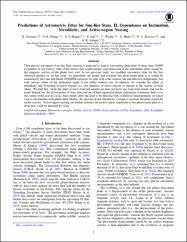Predictions of astrometric jitter for sun-like stars. II. dependence on ınclination, metallicity, and active-region nesting

View/
Access
info:eu-repo/semantics/openAccessDate
2021Author
Krishnamurthy, SowmyaNemec, Nina Elisabeth
Shapiro, Alexander
Işık, Emre
Witzke, Veronika
Mints, Alexey
Krivova, Natalie
Solanki, Sami
Metadata
Show full item recordCitation
Sowmya, K., Nèmec, N. E., Shapiro, A. I., Işık, E., Witzke, V., Mints, A., ... & Solanki, S. K. (2021). Predictions of Astrometric Jitter for Sun-like Stars. II. Dependence on Inclination, Metallicity, and Active-region Nesting. The Astrophysical Journal, 919(2), 94.Abstract
Ultra-precise astrometry from the Gaia mission is expected to lead to astrometric detections of more than 20,000 exoplanets in our Galaxy. One of the factors that could hamper such detections is the astrometric jitter caused by the magnetic activity of the planet host stars. In our previous study, we modeled astrometric jitter for the Sun observed equator-on. In this work, we generalize our model and calculate the photocenter jitter as it would be measured by the Gaia and Small-JASMINE missions for stars with solar rotation rate and effective temperature, but with various values of the inclination angle of the stellar rotation axis. In addition, we consider the effect of metallicity and of nesting of active regions (i.e., the tendency of active regions to emerge in the vicinity of each other). We find that, while the jitter of stars observed equator-on does not have any long-term trends and can be easily filtered out, the photocenters of stars observed out of their equatorial planes experience systematic shifts over the course of the activity cycle. Such trends allow the jitter to be detected with continuous measurements, in which case it can interfere with planet detectability. An increase in the metallicity is found to increase the jitter caused by stellar activity. Active-region nesting can further enhance the peak-to-peak amplitude of the photocenter jitter to a level that could be detected by Gaia.
















